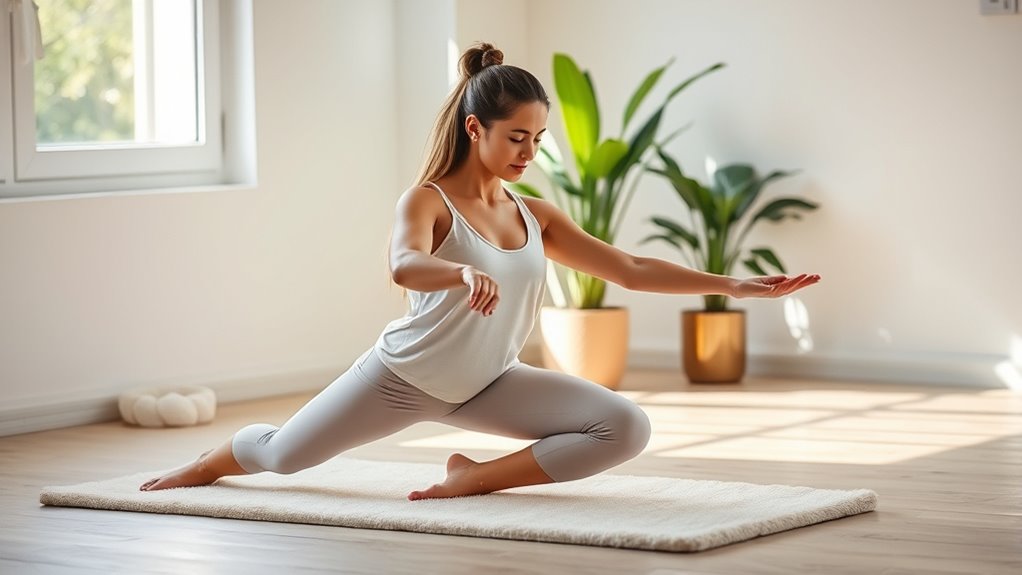Starting with simple yoga poses at home like Mountain, Child’s Pose, and Downward Dog helps build strength and flexibility while promoting mindfulness. Focus on steady, deep breathing to stay centered and safe during each pose. Incorporating breathing exercises and basic meditation can deepen your practice and enhance both mental and physical health. As you continue, you’ll discover more techniques that support your journey toward wellness—just keep exploring.
Key Takeaways
- Start with foundational poses like Mountain (Tadasana) and Child’s Pose (Balasana) to build confidence and stability.
- Focus on proper breathing techniques, such as deep diaphragmatic breathing, to enhance relaxation and focus during poses.
- Incorporate simple poses that can be done at home without equipment, emphasizing safe alignment and comfort.
- Combine poses with mindful meditation and breathing exercises to deepen your practice and promote mental calmness.
- Gradually increase complexity, ensuring proper form and consistency to develop a sustainable and enjoyable yoga routine.

Starting yoga can feel overwhelming, but understanding the basics makes it accessible and enjoyable. One of the most fundamental aspects to focus on is your breathing. Breathing techniques are the foundation of many yoga practices because they help you stay present and calm. As you begin, pay attention to your inhale and exhale, making each breath smooth and deep. Try to breathe through your nose, filling your lungs completely, then slowly exhale. This simple practice helps you connect with your body and keeps your mind centered. Incorporating breathing techniques into your routine can reduce stress and improve your focus during your practice.
In addition to breathing, meditation practices are a valuable tool for beginners. Meditation helps you develop mindfulness, which is essential for staying attentive during yoga poses. You don’t need to sit in a complex position; even a few minutes of focused breathing and awareness can make a big difference. As you settle into your yoga session, take a moment to close your eyes, breathe deeply, and notice your thoughts without judgment. This practice helps you cultivate a sense of calm and enhances your overall yoga experience. Meditation is not just about quieting your mind; it’s about learning to observe your thoughts and feelings with kindness, which can deepen your connection to your body and breath.
When you combine breathing techniques with meditation practices, you create a powerful synergy that supports your physical and mental well-being. For example, practicing slow, controlled breathing during yoga poses can help you maintain balance and stability. It also prevents you from holding your breath or overexerting yourself, making your practice safer and more effective. As you become more comfortable, you might explore different breathing exercises, such as diaphragmatic breathing or alternate nostril breathing, to further enhance your practice. Moreover, understanding Gold IRA options can be an important consideration for long-term financial planning beyond your physical well-being.
Frequently Asked Questions
How Often Should Beginners Practice Yoga Each Week?
You might wonder how often to practice yoga as a beginner. For the best results, aim for consistency by practicing 3 to 4 times a week. This beginner schedule helps you develop a routine without feeling overwhelmed. Focus on maintaining frequency, so yoga becomes part of your lifestyle. Remember, regular practice improves flexibility and strength, making it easier to progress over time. Stay patient and listen to your body.
Can I Do Yoga if I Have Joint Pain?
Yes, you can do yoga with joint pain, but focus on joint-friendly poses and listen to your body. Use modifications for pain, like avoiding deep stretches or high-impact moves. Gentle poses such as seated stretches or gentle twists can help improve flexibility without stressing your joints. Always consult your doctor before starting, and consider working with a yoga instructor who can guide you through safe, pain-free modifications tailored to your needs.
What Should I Wear for Home Yoga Practice?
When practicing yoga at home, you should wear comfortable clothing that allows free movement. Opt for breathable fabrics like cotton or moisture-wicking materials to stay cool and dry. Your yoga attire doesn’t need to be fancy—just guarantee it fits well and doesn’t restrict your movements. Loose-fitting tops and stretchy pants or leggings are ideal, helping you stay focused on your practice without distraction.
How Do I Prevent Injuries During Yoga?
To prevent injuries during yoga, listen to your body and avoid pushing too hard. Incorporate yoga props like blocks or straps to support your poses, and focus on proper alignment. Remember, yoga isn’t just about flexibility; it also offers meditation benefits that promote mindfulness and reduce stress, helping you stay safe. With patience and awareness, you can enjoy a safe, injury-free practice at home.
Are There Specific Poses for Improving Flexibility?
Did you know that consistent stretching routines can improve flexibility by up to 20% in just a few weeks? To enhance flexibility milestones, focus on poses like downward dog, forward bends, and lunges. These stretches target key muscle groups, gradually increasing your range of motion. Incorporate these poses into your routine regularly, and you’ll notice better flexibility and reduced muscle tension over time.
Conclusion
Starting with simple poses like downward dog can transform your daily routine. Imagine Sarah, a busy mom, who began practicing these basics each morning. Within weeks, she felt more energized and less stressed. You can experience this too—by committing to just a few minutes a day, you’ll notice improvements in flexibility and calmness. Remember, consistency is key. Keep practicing these beginner poses, and you’ll soon enjoy the physical and mental benefits of yoga right at home.
Alfons is the visionary leader and driving force behind Voyager Info’s success. As the Editor in Chief, he brings a wealth of experience and an unwavering passion for travel to the helm of our cruise-centric platform.
With a lifelong fascination for exploring new horizons, Alfons discovered his love for the ocean and cruising at a young age. From sailing across pristine Caribbean waters to embarking on daring expeditions to far-flung destinations, he has amassed a treasure trove of first-hand experiences in the world of cruising.










